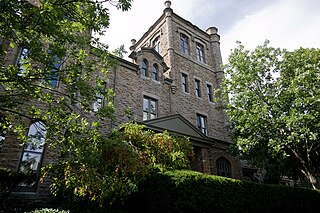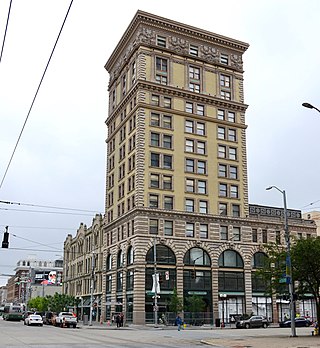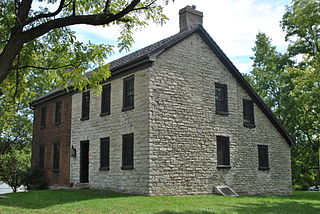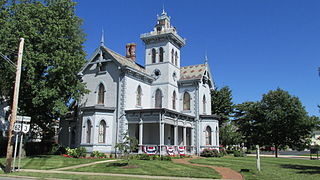
The International Peace Museum is a non-profit, peace museum located on historic Courthouse Square in downtown Dayton, Ohio, United States. The museum's mission is to promote, through education and collaboration, a more equitable, civil, and peaceful world. Its programs and exhibits are non-partisan, secular, and feature themes of conflict resolution, equity, social justice, tolerance, and protecting our natural world. It commemorates the 1995 Dayton Agreement that ended the war in Bosnia. It is "America's only brick-and-mortar peace museum."

The Dayton Street Historic District is located in the Old West End neighborhood of Cincinnati, Ohio, United States. It was once known as "Millionaires' Row" for the prominent industrialists who resided in a row of opulent mansions built between 1850 and 1890. It is bounded by Bank Street, Poplar Street, Linn Street, and Winchell Avenue. The district was designated and listed on the National Register of Historic Places on January 25, 1973.

The Dayton View Historic District is a 680-acre (2.8 km2) sector of Dayton, Ohio, United States, developed in the late 19th century and consisting of 219 structures, that is listed on the National Register of Historic Places.

The Kenilworth Avenue Historic District is a historic district in the northwestern portion of Dayton, Ohio, United States. Composed largely of houses constructed after the Great Flood of 1913, the district features examples of several prominent architectural styles, and it has received both local and federal recognition.

The W.C. Retszch House is a historic residence in the city of Wyoming, Ohio, United States. Built at the opening of the late nineteenth century, it was originally the home of a Cincinnati-area businessman, and it has been designated a historic site because of its distinctive architecture.

The Riddle–Friend House is a historic residence in Wyoming, Ohio. Constructed in the early nineteenth century, it has been home to some of the area's earliest residents, and it has been named a historic site as a rare survivor of the city's earliest years.

Sacred Heart Academy is a historic former residence and school in the city of Cincinnati, Ohio, United States. Built as the home of a wealthy man, it was the location of a Catholic school for most of its history. As a work of a regionally prominent architect, it has been named a historic site.

The Wilson-Gibson House is a historic residence in Cincinnati, Ohio, United States. Constructed in the middle of the 19th century, it features a mix of two prominent architectural styles, and it has been named a historic site.

Hunting Lodge Farm is a historic house located near Oxford in Oxford Township, Butler County, Ohio, United States. Constructed as a hunting lodge, it has been used by multiple prominent local residents, and its distinctive architecture has made it worthy of designation as a historic site.

The Central Avenue Historic District is a small segment of the larger Grafton Hill neighborhood of Dayton, Ohio, United States. Composed of just two blocks near the border between Grafton Hill and Dayton View, the historic district comprises a cohesive collection of houses dating primarily from the turn of the 20th century, and it has been named a historic site.

The Kossuth Colony Historic District, named for Lajos Kossuth, is a nationally recognized historic district bounded by Baltimore Street, Mack Avenue and Notre Dame Avenue in Dayton, Ohio. The Kossuth Colony was built in 1906 to house Hungarian immigrant workers for the Barney and Smith Car Company, a rail car manufacturer that ranked among Dayton's largest and most venerable firms. Comparatively few changes have been made to the forty houses in the colony, although the houses' white picket fences have been removed. Many houses in the district are simple gable-front residences with minimal setbacks, and asbestos siding covers many exterior walls in the district.

The Conover Building, also known as Wright Stop Plaza, is a historic structure in downtown Dayton, Ohio, United States. Constructed at the turn of the twentieth century, the Conover features a mix of architectural styles and sits at a prominent intersection, and it has been named a historic site.

The Insco Apartments is a historic apartment building in downtown Dayton, Ohio, United States. It was designed by Charles Insco Williams, a native of Dayton, and constructed in 1894. Williams designed the structure after an apartment hotel that he had seen on Fifth Avenue in New York City; he did not copy the design slavishly, but many of the architectural themes present in the Insco Apartments were derived ultimately from the unspecified New York City apartment building.

Dr. Jefferson A. Walters House is a historic residence in downtown Dayton, Ohio, United States. Built in 1832 and one of the city's older houses, it was home to two prominent residents of early Dayton, and it has been named a historic site.

The Samuel N. Brown House is a historic residence in southern Dayton, Ohio, United States. Constructed in the 1870s for a prominent industrialist, it has been used for commercial purposes since the 1920s, and it has been named a historic site.
Downtown Dayton is the central business district of Dayton, Ohio, United States. Major reinvestment in the downtown area began heavily in the mid-1990s, and continues today with $2 billion in residential, commercial, health, and transportation developments that has or is taking place in the downtown area.
This is a list of the National Register of Historic Places listings in Dayton, Ohio.

The Lewis Kemp House is a historic pioneer farmstead in the city of Dayton, Ohio, United States. Built for one of the area's earliest residents, it was a religious center in its first years, while later years saw its expansion to its present form. Now located among much newer houses, it is Dayton's oldest surviving residence, and it has been named a historic site.

The Jeff Kimball House is a historic residence in the village of Mechanicsburg, Ohio, United States. Once home to one of the village's leading residents, it has been named a historic site.

The Morris Sharp House is a historic residence in the city of Washington Court House, Ohio, United States. Built to be the home of one of the city's leading citizens, it has remained the architectural landmark that it was designed to be. The house has served as a museum for nearly fifty years, and it has been designated a historic site.






















